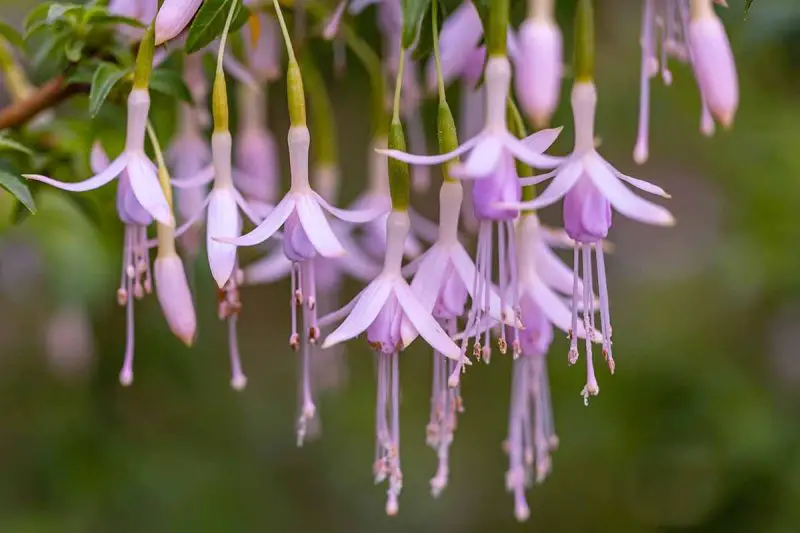Propagating fuchsias is one of the most satisfying ways to expand your garden without spending extra money. These elegant, cascading plants with their bell-shaped blossoms are easy to reproduce, especially from cuttings. By mastering propagation, you can create new, identical plants that carry the same beauty, vigor, and bloom potential as the parent. Whether you grow upright or trailing varieties, fuchsias respond remarkably well to cutting propagation. With the right timing and care, even a small piece of stem can grow into a flourishing plant that blooms for months. This process not only multiplies your collection but also rejuvenates aging plants for stronger, more vibrant growth.
Unlike starting from seeds, which may not produce the same flower colors or plant form, cuttings guarantee exact clones of your favorite variety. Propagation is also quick—new roots can appear in just a few weeks under the right conditions. By understanding when, where, and how to take your cuttings, you’ll enjoy endless cycles of colorful blooms throughout the growing season. This guide will show you, step by step, how to propagate fuchsias easily from cuttings, including how to prepare, root, and care for your young plants until they blossom beautifully.
Understanding Fuchsia Propagation Basics

Propagation is the process of creating new plants from existing ones, and fuchsias are particularly easy to reproduce this way. The most reliable method is through stem cuttings, which involves taking a small section of healthy growth and encouraging it to develop roots. This method ensures that the new plant will share the same characteristics as the parent, including flower color, growth habit, and hardiness. Propagation is usually done in spring or early summer when the plant is in its most active growth phase. During this period, stems are tender, full of energy, and ideal for rooting.
Successful propagation begins with choosing the right material. Softwood cuttings—young, flexible stems that haven’t turned woody—root faster and produce healthier plants. Each cutting should include several leaves and a few nodes, which are the small bumps along the stem where roots will eventually form. It’s important to select stems that are free from pests, diseases, and flower buds. Removing buds helps redirect the plant’s energy toward root growth rather than blooming. Proper selection is the foundation for vigorous, thriving young fuchsias.
Propagation conditions also play a crucial role. Fuchsia cuttings require consistent moisture, high humidity, and moderate temperatures to root successfully. Ideal rooting temperatures range between 65°F and 75°F (18°C–24°C). Too much heat or cold slows root development. Bright, indirect light helps stimulate photosynthesis without drying out the delicate cuttings. When these factors are balanced—healthy cuttings, suitable environment, and gentle care—the propagation process becomes effortless and rewarding. Within weeks, you’ll have new fuchsia plants ready to grow, bloom, and fill your garden with graceful, dangling flowers.
When Is the Best Time to Propagate Fuchsias
Timing plays a vital role in the success of fuchsia propagation. The best time to take cuttings is during spring or early summer when the plant is actively growing and producing fresh, vigorous stems. At this stage, the plant’s tissues are full of moisture and nutrients, allowing cuttings to root faster. Propagating too early in cold weather slows root formation, while doing it too late in the season may not give the new plants enough time to establish before winter. The ideal moment is when the parent plant is healthy, full of lush green growth, and not yet in full bloom.
Temperature and light conditions also determine when to propagate successfully. Fuchsias root best in mild, stable temperatures between 65°F and 75°F (18°C–24°C). During this period, there is enough warmth to encourage root development without drying the tender stems. Avoid propagating during extreme heat or cold, as these stress the cuttings and increase the risk of wilting or rotting. Soft morning light and consistent humidity levels create the perfect environment for rooting. If growing indoors, you can propagate almost any time of year by controlling light and temperature conditions.
For gardeners in colder climates, late spring is the safest propagation window. Taking cuttings after frost danger has passed ensures that young plants can grow without sudden temperature shocks. In warmer or tropical regions, propagation can be done nearly year-round, provided the plants are not exposed to harsh midday sunlight. Regardless of your region, always choose a time when your fuchsias are in their strongest growth phase. By timing propagation correctly, you ensure fast rooting, sturdy young plants, and continuous flower production throughout the growing season.
How to Take the Perfect Fuchsia Cuttings
Selecting and Preparing Healthy Stems
The first step in successful propagation is choosing the right stems for your fuchsia cuttings. Select softwood growth—young, flexible stems that are firm but not woody. These shoots contain the right balance of nutrients and hormones for rapid root development. Each cutting should be around three to four inches long and include at least two or three sets of leaves. Avoid any stems with flowers or buds, as they divert energy from root growth. Using sterilized scissors or pruning shears, make a clean cut just below a leaf node, where roots are most likely to form.
Once you’ve gathered the cuttings, remove the lower leaves to expose the nodes while leaving a few at the top for photosynthesis. If the remaining leaves are large, trim them in half to reduce water loss. To prevent fungal problems, dip the cut ends in a rooting hormone powder or gel, which also stimulates faster root formation. Prepare a moist, well-draining growing medium such as a mix of peat and perlite or coconut coir and sand. This medium retains enough moisture while allowing air circulation around the stems, keeping them healthy and promoting strong, early root growth.
Rooting and Caring for the Cuttings
After preparing the cuttings, it’s time to plant them in their rooting medium. Use small pots or trays with drainage holes and insert each cutting deep enough so that at least one node is below the soil surface. Gently press the soil around each stem to provide stability. Water lightly to settle the medium without making it soggy. Cover the cuttings with a plastic dome or clear bag to create a humid microclimate that retains moisture. Keep them in bright, indirect light and maintain a consistent temperature around 70°F (21°C).
Check the moisture level daily—soil should remain damp but not wet. Mist the leaves occasionally to maintain humidity and prevent wilting. After two to three weeks, you’ll notice new leaves or slight resistance when tugging on the stem, signs that roots have begun to form. Once the cuttings have established a healthy root system, gradually remove the cover to acclimate them to normal humidity. In another week or two, the young fuchsias will be ready for transplanting into individual pots. With careful attention during this stage, you’ll soon have thriving new plants ready to bloom.
Transplanting Rooted Fuchsia Cuttings
Once your fuchsia cuttings have developed a strong root system, it’s time to transplant them into individual containers or garden beds. This step allows the young plants to grow freely and establish a more extensive root network. Choose small pots around four to six inches in diameter with good drainage holes to prevent waterlogging. Fill them with a well-draining, nutrient-rich soil mix made from equal parts compost, peat, and perlite. Gently remove the rooted cuttings from their propagation trays, taking care not to damage the tender roots. Place each cutting in the center of the pot and cover with soil just up to the base of the lowest leaves. Water lightly to settle the soil.
After transplanting, place the young fuchsias in a bright, sheltered location with filtered light. Avoid exposing them to direct sunlight for the first few days, as sudden heat can stress or scorch their tender foliage. Gradually increase light exposure as the plants adjust to their new environment. Keep the soil consistently moist but never soggy. In this early stage, overwatering can still cause root problems, while dryness may slow growth. Within two weeks, the plants will begin producing new leaves and stems, signaling they are ready to enter the active growth phase.
Transplanting also provides an opportunity to shape and strengthen your fuchsias. Pinch the growing tips after the plants reach about six inches tall to encourage branching and bushier growth. This practice helps create fuller plants with more flowering stems later in the season. Continue watering and providing moderate humidity as the plants mature. With proper transplanting care and patience, your young fuchsias will grow into healthy, vibrant plants ready to produce a cascade of colorful blooms that last from late spring through autumn.
Caring for Young Fuchsia Plants After Propagation
Light and Temperature Management
After propagation, young fuchsias need controlled light and temperature conditions to grow strong and compact. Bright, indirect sunlight is best for these delicate plants. Direct exposure, especially during midday, can scorch their tender leaves and cause dehydration. Place your pots where they receive soft morning light and gentle afternoon shade. Indoors, an east-facing window or filtered sunlight through a sheer curtain works perfectly. For outdoor growing, sheltered patios or shaded garden corners are ideal. Consistent temperatures between 60°F and 75°F (16°C–24°C) support optimal photosynthesis and steady growth. Extreme heat can cause leaf curling or bud drop, while temperatures below 50°F (10°C) may slow root development.
To keep the environment stable, avoid placing young fuchsias near air conditioners, heaters, or drafty windows. During hot days, misting helps maintain humidity around the foliage, reducing stress. Maintaining about 50% to 60% humidity keeps leaves vibrant and prevents drying. For greenhouse growers, using ventilation fans ensures proper airflow without temperature spikes. Balanced light, temperature, and humidity allow your fuchsias to establish quickly and develop lush foliage that will later support abundant, colorful blooms. Proper environmental control during this early phase lays the foundation for long-term health and continuous flowering.
Watering and Feeding Routine
Watering correctly is vital for newly propagated fuchsias. These young plants have tender roots that demand consistent moisture but suffer from overwatering. Keep the soil evenly moist, never soaked, and always allow the top inch to dry before watering again. Early morning watering works best, allowing excess moisture to evaporate during the day. In warmer conditions, you may need to water daily, especially for hanging baskets or small pots. However, always check the soil first—too much water invites fungal disease and root rot. For improved drainage, mix perlite or coarse sand into your potting medium.
Feeding supports growth once roots have developed. Start fertilizing after three to four weeks using a diluted, balanced fertilizer like 10-10-10 every two weeks. Gradually transition to a phosphorus-rich formula such as 10-30-20 to promote blooming later. Organic options like compost tea or liquid seaweed provide gentle nourishment while improving soil texture. Avoid overfertilizing, as it can cause nutrient burn or excessive leafy growth. Consistent hydration combined with moderate feeding strengthens the root system, enhances stem thickness, and prepares your young fuchsias for vigorous flowering once the growing season begins.
Pruning and Acclimating to Outdoor Conditions
Pruning is one of the most effective ways to help your young fuchsias grow fuller and healthier. When plants reach about six to eight inches tall, pinch off the top growth just above a leaf node. This stimulates lateral branching, producing bushier plants with more flowering stems later in the season. Each new branch becomes a potential bloom site. Continue light pruning every few weeks to maintain compact growth. Regularly remove yellow or weak leaves to improve airflow and prevent fungal problems. Pruning also helps balance the plant’s energy, ensuring even development between roots, stems, and foliage.
Before moving the plants outdoors permanently, they must be gradually acclimated. Begin by placing them outside in partial shade for two to three hours daily, increasing exposure over ten to fourteen days. This process, known as hardening off, prevents shock from sudden changes in sunlight, wind, or temperature. Avoid direct midday sun and strong breezes during the adjustment period. Once fully acclimated, your fuchsias will adapt seamlessly to outdoor conditions. Proper pruning and acclimation strengthen their structure, making them more resilient and ready to produce cascades of flowers throughout the warm months.
Common Mistakes When Propagating Fuchsias
Overwatering and Poor Drainage
One of the most common mistakes during fuchsia propagation is overwatering. Newly cut stems are delicate and easily damaged by excess moisture. When soil stays soggy, oxygen cannot reach the roots, leading to rot and fungal infections. The first symptoms are soft, blackened stems or drooping leaves even when the soil feels wet. Many beginners water too often, thinking the cuttings need constant hydration, but this actually suffocates the developing roots. The key is to keep the soil consistently moist, not saturated. Allow the top layer to dry slightly before watering again. Using a well-draining medium, such as a mix of peat and perlite, prevents water from pooling around the base.
Drainage holes are also critical when rooting cuttings in pots or trays. Without them, even careful watering can cause water buildup that kills roots before they form. Always ensure containers allow excess moisture to escape easily. Covering cuttings with plastic to retain humidity is helpful, but ventilation is equally important. Remove the cover periodically to prevent condensation and mold. With the right moisture balance, your fuchsias will develop strong, white roots quickly, setting the foundation for healthy growth and abundant future blooms.
Using Weak or Flowering Stems
Another frequent error is choosing the wrong type of stem for propagation. Fuchsia cuttings should come from healthy, non-flowering shoots, as stems carrying buds or flowers divert their energy toward blooming rather than rooting. When a cutting is taken from a flowering branch, it struggles to develop roots because its stored nutrients are already being used to support blossoms. The result is often a wilted cutting that fails to survive. For best results, select softwood stems—young, green growth that feels firm but flexible. These stems contain the perfect moisture balance for quick rooting.
Avoid using old, woody stems because they take much longer to root and are more susceptible to disease. When preparing cuttings, always remove the lower leaves and any buds or flowers before planting. This encourages the cutting to focus on root formation. Clean, sharp tools are essential to avoid bruising the stem tissue. Sterilize scissors or blades between cuts to prevent bacteria transfer. By selecting vigorous, pest-free shoots and removing unnecessary growth, you ensure a much higher success rate and stronger, more resilient fuchsia plants.
Ignoring Light and Temperature Conditions
Light and temperature control are often overlooked but play a huge role in propagation success. Fuchsia cuttings thrive in bright, indirect light—not direct sunlight, which can dry or burn tender stems. If kept in deep shade, they may fail to produce roots or grow leggy and weak. The best spot is one that receives filtered morning sunlight and remains cool through the afternoon. Indoors, a north- or east-facing window provides ideal brightness. Consistent light levels help maintain photosynthesis without overheating the fragile plant tissues.
Temperature is equally important. Fuchsias prefer a steady range between 65°F and 75°F (18°C–24°C) for root development. If the environment is too cold, roots form slowly; too hot, and the cuttings may wilt or rot. Maintain mild humidity by covering cuttings with a plastic dome or bag, but remember to ventilate daily to prevent mold. Rapid temperature swings, such as moving cuttings from indoors to outdoors too soon, can shock them and halt root growth. By providing stable, bright, and temperate conditions, you’ll create an ideal rooting environment that helps your fuchsias establish quickly and flourish beautifully.
Seasonal Care Tips for Propagated Fuchsias
Spring Care
Spring is the ideal season to nurture newly propagated fuchsias, as it marks the start of active growth. Begin by repotting rooted cuttings into slightly larger containers filled with rich, well-draining soil. Place the plants in a location with bright, indirect sunlight to encourage compact and vigorous growth. Water consistently, ensuring the soil remains moist but not soggy. This helps strengthen the roots and supports the development of new shoots. As the weather warms, gradually expose the plants to longer daylight hours, which stimulates leaf and bud formation.
Feed your young fuchsias every two weeks with a diluted, balanced fertilizer to promote healthy foliage. Prune lightly to remove weak or crowded stems, allowing better air circulation and light penetration. Inspect leaves regularly for aphids or whiteflies, as pests are most active in spring. If temperatures fluctuate, bring potted plants indoors during cold nights. By the end of spring, your propagated fuchsias should have strong, branching structures and be ready to burst into bloom as summer approaches. Proper early-season care ensures a long, colorful flowering cycle throughout the year.
Summer Care
Summer marks the peak growth and blooming season for fuchsias, but it also brings challenges like heat and dehydration. Propagated fuchsias prefer bright light but not intense sun; too much exposure can scorch leaves and cause buds to fall. Morning sunlight followed by afternoon shade is ideal. Water deeply two to three times a week, or more often during heatwaves, ensuring the soil stays evenly moist. Adding mulch helps retain moisture and keeps the roots cool. Avoid letting pots dry out completely, as fuchsias are sensitive to drought.
Feed your plants every two weeks with a phosphorus-rich fertilizer to promote vibrant flowers. Remove wilted blooms and dead leaves regularly to encourage continuous flowering. For container fuchsias, ensure pots have adequate drainage and never sit in standing water. In very hot climates, lightly mist the foliage in the morning to maintain humidity. Prune leggy stems to keep a compact shape and encourage new growth. Summer is also the time to watch for pests such as spider mites, which thrive in dry heat. With consistent watering, gentle shading, and attentive care, your fuchsias will bloom abundantly all summer long.
Fall Care
As autumn approaches, your fuchsias naturally slow their growth and prepare for rest. The cooling weather helps extend their blooming period, but this is also the time to begin reducing maintenance. Continue watering moderately, allowing the top inch of soil to dry between sessions. Stop fertilizing by late fall so the plants can transition into dormancy. Remove faded blooms, yellow leaves, and weak stems to keep the plants healthy and reduce disease risk. Clean, tidy plants are less likely to attract pests during cooler months.
If your fuchsias are in pots, trim back the stems by one-third to help conserve energy. Move them indoors before the first frost or place them in a greenhouse with stable temperatures above 50°F (10°C). Gradually acclimate them to indoor conditions by keeping them in shaded areas for several days before moving inside. For garden fuchsias in mild climates, cover the soil with mulch or straw to protect roots from temperature swings. Proper fall preparation ensures your propagated fuchsias remain strong through winter and return with renewed vigor and larger blooms in the spring.
Winter Care
Winter is the rest period for most fuchsias, especially those grown from cuttings earlier in the year. If you live in a cold region, move the plants indoors before frost sets in. Keep them in a cool, bright room where temperatures stay between 45°F and 55°F (7°C–13°C). During this time, water sparingly—just enough to keep the soil from drying completely. Overwatering during dormancy is one of the biggest mistakes gardeners make, as it causes root rot. Avoid fertilizing until new growth appears in spring.
For hardy outdoor fuchsias, prune stems back to about six inches above the soil after the first frost, then cover the base with mulch, straw, or leaves to insulate the roots. Indoor plants may lose some leaves as they rest, which is perfectly normal. Remove any dead or moldy material to maintain good hygiene. Make sure the plants still receive bright light during the day, even while dormant. By late winter, you’ll notice small buds or new shoots—this signals the time to resume watering and feeding. With proper winter care, your propagated fuchsias will awaken strong, healthy, and ready for another season of spectacular blooms.
FAQs About Propagating Fuchsias
How long do fuchsia cuttings take to root?
Fuchsia cuttings typically take two to four weeks to root, depending on temperature and humidity. Warm, stable conditions around 70°F (21°C) and consistent moisture help speed up rooting. You’ll know roots have formed when new leaves appear or the cutting resists gentle pulling.
Can I propagate fuchsias in water?
Yes, fuchsias root easily in water. Place cuttings in a glass of clean, room-temperature water, ensuring the lower nodes are submerged. Change the water every few days to prevent bacterial buildup. Once roots reach about an inch long, transfer the cuttings to soil for further growth.
Why are my fuchsia cuttings wilting?
Wilting cuttings often result from low humidity or overexposure to sunlight. Keep them in bright, indirect light and maintain a humid environment by covering with plastic. Overwatering can also suffocate new roots. Adjust light, moisture, and airflow for recovery and stronger growth.
What’s the best soil mix for rooting fuchsias?
The ideal soil for rooting fuchsias combines moisture retention and drainage. A mix of peat moss, perlite, and coarse sand works perfectly. It holds enough water for root development while preventing sogginess. Avoid heavy garden soil, which restricts airflow and causes fungal issues.
When can I plant propagated fuchsias outdoors?
You can plant propagated fuchsias outdoors once the risk of frost has passed and temperatures stay above 55°F (13°C). Gradually acclimate them to outdoor light and wind by hardening off for about ten days. This transition helps strengthen stems and prevents transplant shock.
Conclusion
Propagating fuchsias from cuttings is both simple and rewarding, allowing you to create endless cascades of colorful blooms season after season. With patience, proper timing, and the right environment, even a small stem can grow into a thriving, flower-filled plant. From selecting healthy cuttings to providing gentle care through each growth stage, every step ensures success. Whether you’re expanding your collection or sharing new plants with friends, propagation keeps the beauty of fuchsias alive and blooming. With love, light, and consistency, your efforts will be rewarded with a stunning garden overflowing with elegance and vibrant color all year long.






